Memes: intertextualidade e redundância
DOI:
https://doi.org/10.34630/tth.vi4.5741Keywords:
meme, image, video, caption, communication, intertextualityAbstract
Digital memes have transcended their initial role as mere sources of entertainment on the internet to become crucial elements in the formation and dissemination of contemporary culture, acting as potent vectors of meaning, humor, social critique, and, in certain cases, misinformation. This work delves into the multifaceted nature of memes, exploring the intertextuality and redundancy that characterize them. It addresses how memes, through their ability to capture and disseminate the complexities of human experience in a concise manner, influence digital society, reflecting technological and cultural changes, and challenging our perception of communication, art, and cultural expression in the digital age. The analysis offers a critical reflection on the significant role of memes in digital culture, highlighting how they act not only as cultural phenomena but also as instruments of social and political influence, capable of uniting and dividing.
References
Beltrão, L. (1967). Folkcomunicação: um estudo dos agentes e dos meios populares de informação de fatos e expressão de ideias [Tese de Doutorado, Universidade de Brasília].
Bennett, W. L., & Segerberg, A. (2012). The logic of connective action. Information, Communication & Society, 15(5), 739–768. https://doi.org/10.1080/1369118X.2012.670661
Burgess, J. (2008). 'All your chocolate rain are belong to us?' Viral video, YouTube and the dynamics of participatory culture. In G. Lovink & S. Niederer (Eds.), Video Vortex Reader: Responses to YouTube (pp. 101-109). Institute of Network Cultures.
Chagas, V. (2016). 'Não tenho nada a ver com isso': Cultura política, humor e intertextualidade nos memes das Eleições 2014. In E. U. Cervi, M. G. Massuchin, & F. C. de Carvalho (Eds.), Internet e eleições no Brasil. CPOP.
Dawkins, R. (1976). The selfish gene. Oxford University Press.
Huntington, H. E. (2016). Pepper spray cop and the American dream: Using synecdoche and metaphor to unlock internet memes’ visual political rhetoric. Communication Studies, 67(1), 77–93. https://doi.org/10.1080/10510974.2015.1121898
Jenkins, H., Ford, S., & Green, J. (2013). Spreadable media: Creating value and meaning in a networked culture. NYU Press.
Lee, B., & Campbell, V. (2016). Looking out or turning in? Organizational ramifications of online political posters on Facebook. The International Journal of Press/Politics, 21(3), 313–337. https://doi.org/10.1177/1940161216645335
Lippmann, W. (2008). Opinião pública. Vozes.
Shifman, L. (2014). Memes in digital culture. MIT Press.
McLuhan, M. (1964). Understanding media: The extensions of man. McGraw-Hill.
Milner, R. M. (2013). Hacking the social: Internet memes, identity antagonism, and the logic of lulz. Fibreculture Journal, (22), 62-92.
Knobel, M., & Lankshear, C. (2007). Online memes, affinities, and cultural production. In M. Knobel & C. Lankshear (Eds.), A New Literacies Sampler (pp. 199-227). Peter Lang.
Wiggins, B. E., & Bowers, G. B. (2015). Memes as genre: A structurational analysis of the memescape. New Media & Society, 17(11), 1886-1906. https://doi.org/10.1177/1461444814535194
Gal, N., Shifman, L., & Kampf, Z. (2016). 'It gets better': Internet memes and the construction of collective identity. New Media & Society, 18(8), 1698-1714. https://doi.org/10.1177/1461444814568784
Rintel, S. (2013). Crisis memes: The importance of templatability to Internet culture and freedom of expression. Australasian Journal of Popular Culture, 2(2), 253-271.
Downloads
Published
How to Cite
Issue
Section
License
Copyright (c) 2024 The Trends Hub

This work is licensed under a Creative Commons Attribution-NonCommercial-NoDerivatives 4.0 International License.


